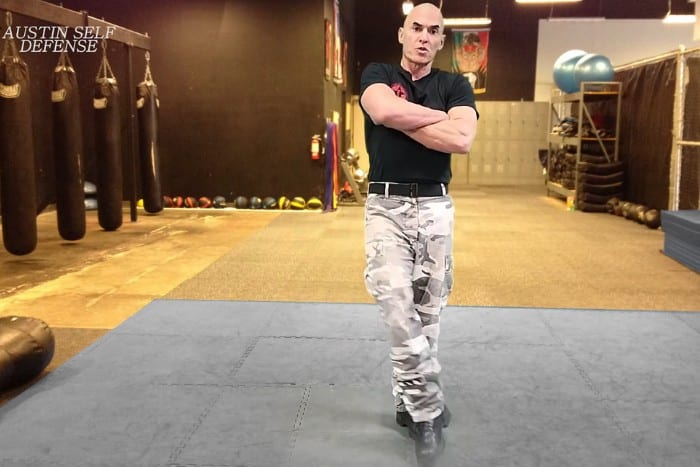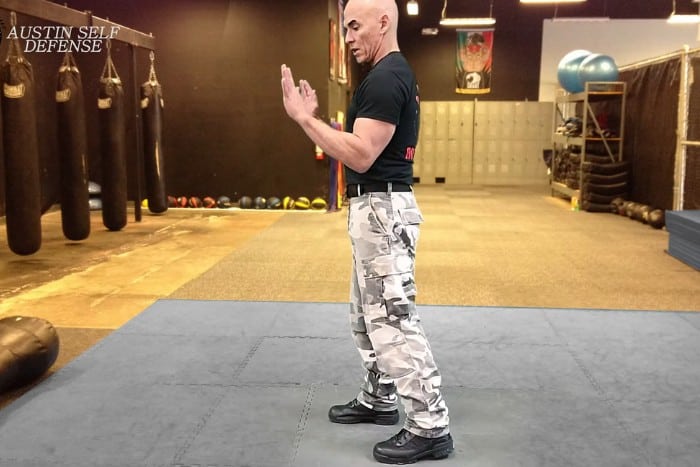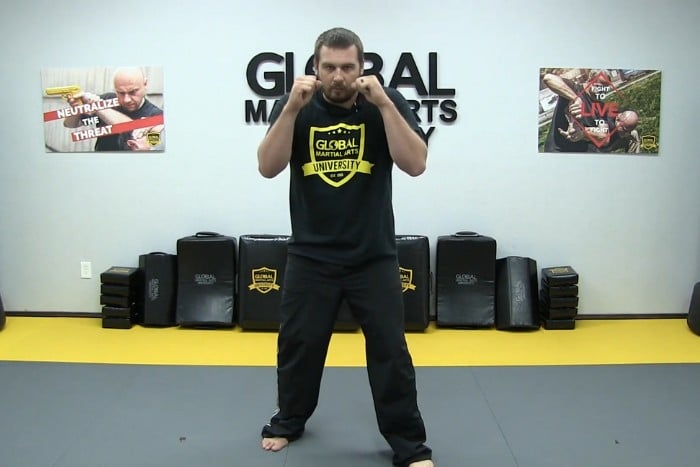Krav Maga stances are the first things you’ll learn in any class, and you’ll be using them almost daily. Thus, knowing about them is essential. But merely execution should not be your focus. It’s also important to know which stance is meant for which situation.
Passive, semi-passive, and fighting are the three Krav Maga stances. Like everyday situations, the passive stance is you unprepared for a fight. The semi-passive stance is when you’re trying to de-escalate a fight but are ready for an attack. The fighting stance is for full engagement in a fight.
In this article, we’ll explore the three stances of Krav Maga in detail and also see their execution method, advantages, and disadvantages.
The Three Krav Maga Stances
1. Passive Stance
Passive stance is how you usually stand when you’re not expecting an attack or could never perceive an incoming attack.
Usually, such attacks are from the side or the back, where you do not even have a split second to react out of reflex.
Even if the person is in front, you did not anticipate them launching an attack on you.

How To Be In A Passive Stance?
A passive stance is any stance where you’re not ready to fight physically and mentally.
For example, it could be you standing with feet shoulder-width apart and hands by your side which is the neutral passive stance.
It could also mean standing with your arms behind your back, hands in your pockets, crossing your arms, and leaning on one leg, also known as the natural passive stance.
You’re more likely to be in a natural passive stance than a neutral one in real life.
Further, leaning against a wall, sitting somewhere, using your phone, relaxing on the ground, tying your shoelaces, and lying down are all examples of passive stance.
Advantages Of The Passive Stance
A significant advantage of the passive stance is that it gives your attacker the illusion of you being vulnerable even if you know how to defend yourself.
Further, your attacker wouldn’t usually react aggressively since you’re not making any swift movements that might force them to harm you.
Lastly, with a passive stance, you’re conserving the maximum energy and saving it for the actual fight if it happens.
Disadvantages Of The Passive Stance
The most significant disadvantage of the passive stance is that you’re actually vulnerable to an attack and would not usually be able to defend yourself from the first hit.
The caveat to this being you hear the sound of your attacker’s movement beforehand or anticipate a strike from their movement.
The toughest ones to prevent are attacks from the side or the back or whenever you’re not looking at your attacker.
It is also common to fall when you’re in a passive stance since you’re not consciously holding the ground with your feet.
2. Semi-Passive Stance
The objective of the semi-passive stance is to de-escalate a fight while still being able to defend yourself.
You create a little distance from your attacker through your words and body language, conveying, “Hey, I don’t want any trouble. Leave me alone.”
Semi-passive stance gives you the time to think and create distance.

How To Be In A Semi-Passive Stance?
Keep your feet shoulder-width apart. If you’re right-handed, your right foot goes slightly back, almost halfway past the front foot but not completely past it. It is around half the length of your front foot.
You’re still squared, i.e., your shoulders and hips are up and facing your attacker. Your hands are up to chest height, and the elbows are close to the rib cage, protecting it.
The palms face forward, and the fingers face the ceiling or the sky. Mentally you’re ready to deal if an attack happens.
Advantages Of The Semi-Passive Stance
Semi-passive stance makes you look non-threatening and allows you to dissolve the fight. It’s a pretty good de-escalation move in line with the first principle of Krav Maga, i.e., to always avoid a fight.
However, your mind by now is also assessing the situation, what you will do about it, and what opportunities you have.
Further, it also gives you the time to think about what objects are lying around that you can use as potential weapons or if you’re carrying any object which can be deployed as a weapon.
More importantly, it also gives you the time to see what are some other threats associated with your attacker.
For example, it could be them trying to pull out a weapon or another attacker coming in to aid them.
Disadvantages Of The Semi-Passive Stance
A disadvantage of the passive stance is that your feet are still not firm on the ground like in the fighting stance.
If your attacker is aggressive and quick, you might not be able to get a chance to balance yourself in case you’re struck hard and fast.
3. Fighting Stance
The fighting stance is when you’re fully ready to fight. It is to defend yourself against incoming attacks and launch effective counters.
There’s no going back from here once the fight starts, and you’re aware of that.

How To Get In The Fighting Stance?
Place your feet just outside your shoulder line, so you’re nice and wide. Many people usually teach that you keep your dominant foot backward, i.e., if you’re right-handed, keep your right foot backward.
However, I suggest keeping the non-dominant foot forward (left in our example case). It doesn’t need to be a huge step, just a small comfortable one.
Remember, both these methods essentially get you in the same position. But, I find a slight difference in the mindset.
By keeping my left foot forward instead of the right one backward, I am essentially stepping into the fight with the mentality of attacking.
It’s a subtly aggressive difference, and it also closes the distance a bit between you and your attacker.
Now lift your back foot slightly so that only the ball of the foot (the round bony part just under and below the first toe) is touching the ground.
The forward foot should be flat, and the toes of both feet should point toward your attacker. The knees of both feet should be slightly bent. You DON’T need to crouch—just a light bend.
The most important part of this stance is the shifting of your weight. Keep around 30% of your weight on your back leg, and approximately 70% should shift to the front leg.
This will keep you nice and ready for a fight and help you move around faster. But unlike the semi-passive stance, the back foot is entirely past the front foot.
The hands would be up in the air like the semi-passive stance but just a bit closer to your face to guard it. Make sure it isn’t too close, or else you’ll hit your face with your own hand in the event of an attack.
Some people also prefer making a fist rather than keeping their hands open. The elbows, again, protect your ribs. The body is squared up to your attacker as you’re facing forward.
Finally, don’t tense up your shoulders and keep your chin tucked in slightly.
Advantages Of The Fighting Stance
The fighting stance gives your feet a firm hold on the ground to provide front-to-back and side-to-side stability.
This prevents you from going down on the ground easily, which is one of the worst positions to be in, in a street fight. Also, you’re fully prepared for an attack from all angles and ready to counter while blocking.
The fighting stance also allows you to go for pre-emptive strikes so that you can neutralize any threat before it harms you.
Disadvantages Of The Fighting Stance
When used in situations still building up, the fighting stance can immediately escalate things into a fight. It should only be used when there’s no backing down from a physical conflict.
This means that you feel your attacker will strike first or draw a weapon that can turn things ugly for you.
Incorrectly reading a situation and being the aggressor is against the basic principle of Krav Maga, which never encourages being the first one to attack unless inevitable.
Conclusion
Krav Maga teaches defensive techniques from all these stances. As a practitioner, you should also know which stance to use in what situation.
Further, you should also know how to get into them as soon as possible correctly. Incorrect choice of stances or wrong execution will always result in more harm than you would have gotten otherwise.
Do not let your ego get in between when you can avoid a fight, and don’t back down from a fight when it does break out.
